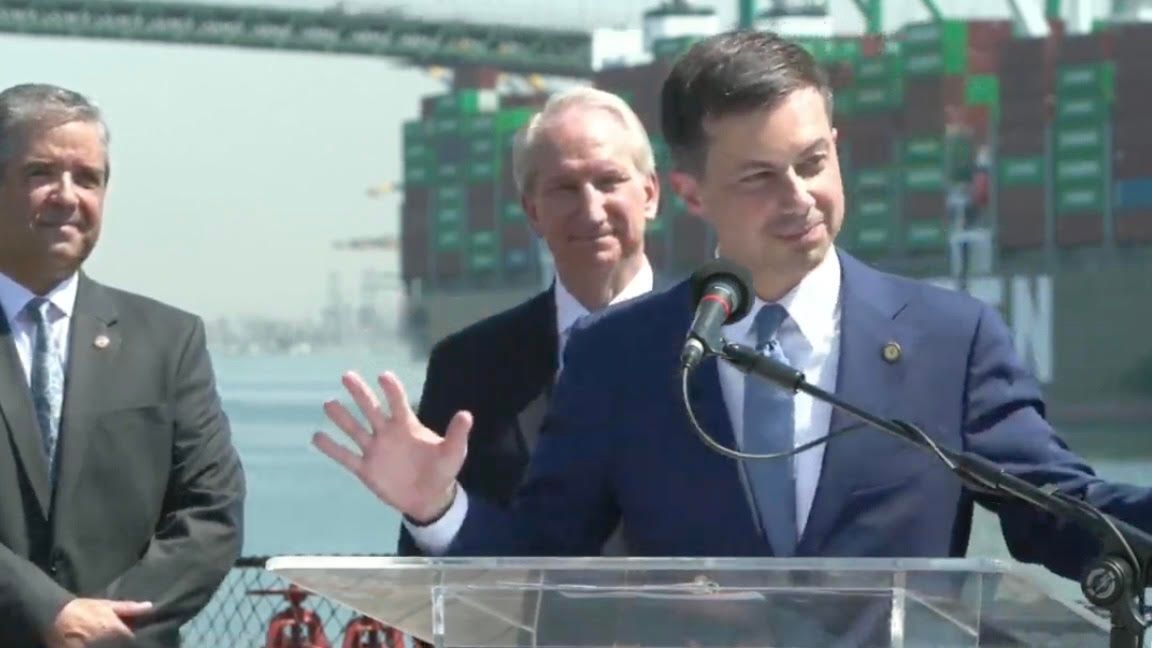LOS ANGELES — With the Port of Los Angeles continuing to handle record amounts of cargo, U.S. Transportation Secretary Pete Buttigieg visited San Pedro Wednesday to announce a $20 million investment that will help trucks and trains move more quickly through the country’s largest trade gateway.
The grant will be used to build a four-lane road over a train track that currently bottlenecks cargo traffic.
“The project here that we’re celebrating is a great example of exactly what the Biden-Harris administration’s vision for building a better America looks like in practice,” Buttigieg said from the deck of the USS Iowa, flanked by LA Mayor Eric Garcetti, Port of LA Executive Director Gene Seroka and U.S. Rep. Nanette Barragan.
The $20 million grant is part of $2.2 billion in funding the administration allocated this year through the Bipartisan Infrastructure Law’s Rebuilding American Infrastructure with Sustainability and Equity program. The grants are for projects that modernize roads, bridges, transit, rail, ports and intermodal transportation in ways that make them more safe, accessible, affordable and sustainable.
Last October, the Port of LA opened an 80-acre Maritime Support Facility to store empty containers and chassis during an unprecedented, COVID-induced shipping frenzy. According to the U.S. Department of Transportation, that facility can be dangerous to access because three heavily used rail tracks circle the area with only one way to cross over them — through a low-clearance tunnel that forces trucks to slow to 5 mph so they don’t get stuck.
Funded with the $20 million federal grant, the Port of LA will get a new multi-lane grade crossing to reduce the amount of time it takes a truck to travel through the area from one minute to five seconds. The DOT estimates it will reduce cargo delays by 2,500 truck-hours daily. Doing so will have multiple beneficial ripple effects, such as improving access to empty chassis and containers, as well as reducing the number of ships at anchor and container dwell times.
It will also reduce the risk of accidents by getting rid of the rail-truck crossing and improve emissions by reducing the number of miles trucks travel.
“This is what good infrastructure investment looks like,” Buttigieg said. “It’s not about the numbers on the page and the dollars in the spreadsheets. It’s about putting them to work to solve problems, and that’s what’s going on right here.”
In addition to the $20 million investment in the new grade crossing at the Port of LA, California will receive $28.2 billion for road and bridge improvements, $10.3 billion for public transit, $1.5 billion for airports and $384 million for EV charging from the Bipartisan Infrastructure Law over the next five years.
Buttigieg noted that the Department of Transportation received $13 billion of applications for $2.2 billion of available funding this year. Projects like the new grade crossing at the Port of LA were selected because they “demonstrated clear and compelling value to the American people,” he said.
The ports of LA and Long Beach handle 35% of all shipping containers coming into the U.S., or about 36% of all U.S. imports. According to the DOT, the ports support $380 billion in trade and 3 million jobs.
Buttigieg praised the Port of LA for its work with the federal government to ease the supply chain crunch that had dozens of ships idling on the water last year, waiting to unload.
“The actions we’ve taken together, improving data sharing, helping to motivate shippers to move their products more quickly, we’ve seen extraordinary progress,” Buttigieg said.
There have been “fewer delays even as the workers here are moving record amounts of cargo at a port complex responsible for more than a third of all the containers coming into or leaving the entire county by sea.”
The Port of LA handled 5% more volume in July than it did a year earlier, Seroka reported last month. Through the first seven months of the year, the port has handled exactly the same number of containers as it did in 2021, when the port had its best cargo year ever.
Seroka expects work on the new four-lane grade crossing to begin within the next 15 to 18 months after the proper reviews have been completed.



